Àlex Mitrani
The opening up of the collection to a new flexibility
Putting things out of place, to refind ourselves. We need to do regular exercises to position ourselves again, to understand things in a different, refreshing way. The great national museums have patrimonial and symbolic requirements that contribute to a certain statism that results in the benefit of the stability and clarity that the works deserve and that visitors need in order to assimilate and make the contents their own. Thus, by force, the permanent collections of these institutions tend to define standards and storytelling of a certain monumentality. To compensate for this, it is necessary to introduce disturbing, impertinent elements. It can be a way to activate the senses in various directions.
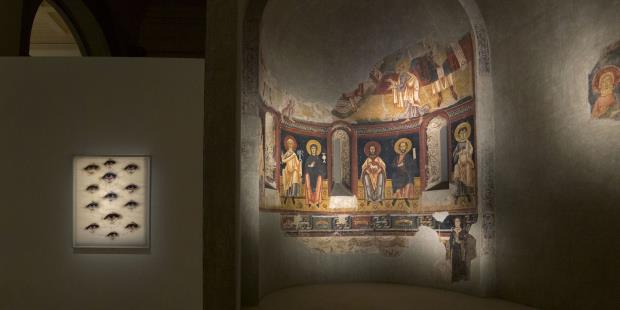
Historical, heritage museums imply looking back at the past, reconstructed in an often evolutionary storytelling. This often leads us to confirming the prejudices that separate the past from the present. But everything we live, everything we love and protect, is part of our present, of contemporaneity. As a response, we want to propose the opening up of the collection to a new flexibility.
Contemporary art and history embrace each other
The disturbing experience of suspending plans and forecasts, the alteration of the professional, economic and personal routines that this pandemic has brought us, forces us to think about our relationship with time, with memory. In times of crisis, anguish or recollection like the present, confirm what we already knew: that art does not speak of history, but speaks of us, invites us to think and meditate on life.
To open up, communicate, reflect, rediscover: After closing ourselves, we need to dream and structure a new opening, to create communication situations, exercise an intellectual “promiscuity” that wakes us up and gives us the warmth and the drive to move forward. Contemporary art and history embrace each other.
The reason for the title of the exhibition Intrusive Dialogues
The title intrusive dialogues refers to a relationship, an interrelation in which there is not a unique, stable nature of things, but an exchange that generates a third reality. Dialogue implies an approach, an openness to the other, but intrusion refers to a certain disengagement, a difference, an awkward or inconvenient situation (in the literal sense but also of disposition in a place). Dialogue is not only established between equals, but also, or rather, between those that are different, strangers. Accepting, looking for this encounter between that which is different, is the necessary gesture for mutual enrichment, in life and in art. All in the present: because everything is now, because the moment we live in is key; our future depends on how we think and act now. The past and the present are offered to us, diverse and equal, because we project ourselves and imagine ourselves.
For example, the wire chair by Jaume Xifra (1974) and the frontal by Durro (12th century) both tell us about pain, suffering as part of sacrifice and the destiny of humanity, a dimension of our existence often erroneously hidden or sublimated. It’s time to think about it, sooner or later.
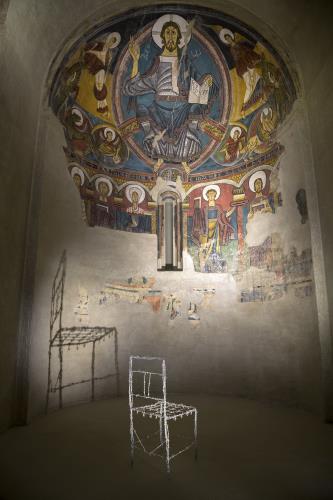
A proposal that is projected on the whole collection: a challenge
The proposal of these dialogues has precedents in the Museu Nacional: the interventions of Perejaume, Francesc Torres or the exhibition Romanesque Picasso, among others, already mark the first ways of connection between contemporary views and the museum’s collections. The same presentation, in the space of the museum’s Dome, of a group of symbolist and noucentista statues facing the large ceramic mural of Joan Miró and Joan Gardy Artigas is a declaration of intent. Now, the collaboration with the Suñol Foundation has allowed for a more extensive intervention.
Intrusive dialogues introduces a new element: the systematic dispersion through all the rooms of the permanent collection of works that generate a rupture, changes of rhythm and provoke new questions. It is the whole storytelling of the museum that was affected by this intervention and this had to be taken into account when putting forward the proposal. It was therefore important to find the right measure that would not unduly alter the current discourse of the museum. The idea was to maintain and allow a leisurely and clear appreciation of each historical moment with an evolutionary and coherent narrative, but this vision could coexist, at the same time, with scattered parentheses -surprising at times, also designed to activate, by contrast, the communicative power of historical works in terms of current events. Thus we have tried to make a subtle and at the same time transgressive intervention and we have tried to avoid spectacularities and effects.
The reverse shadow (Untitled, 1980) by Eva Lootz (1980) is paired up with the mantle of the Virgin of Mercy by Bonanat Zaortiga (1330-1440): from the transparency of the greys or from the density of the gold, the welcoming light of the universe is offered to us as a warm and silent refuge.
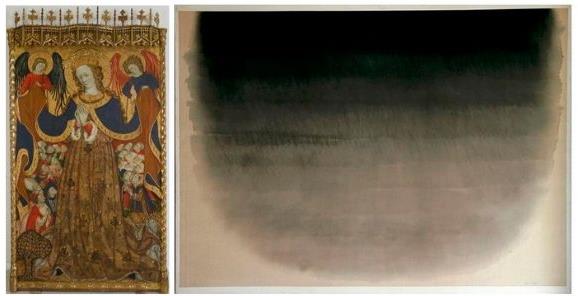
+ Bonanat Zaortiga, Virgin of Mercy 1430-1440
+ Bonanat Zaortiga, Virgin of Mercy 1430-1440
Postwar and second avant-garde art at the Museu Nacional
Intrusive Dialogues is part of the Museu Nacional’s intensive work programme in order to constitute and present a complete, coherent and critical collection of post-war and second avant-garde art in Catalonia. The emergence of contemporary art (understood as second avant-garde art that emerged after the Spanish Civil War and World War II) represents not only a logical extension of the museum’s chronology, but also the emergence of a series of works that, due to their spirit of modernity and their transgression of cultural categories and traditional technical formats, question the ways of looking and the very conception of a work of art.
The construction of a multiple and enriching storytelling of this period of our recent history cannot be done today from the unique vision of a single museum. But it needs decentralised collaboration between institutions of different sizes and scope (naturally not only in Barcelona), as well as complicity between private (non-profit) and public centres. One of these complicities is the one established with the Fundació Suñol which, in parallel with its avant-garde programming, has one of the best collections of contemporary art in the country.
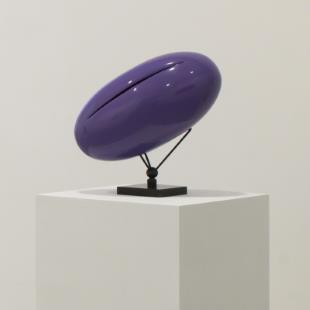
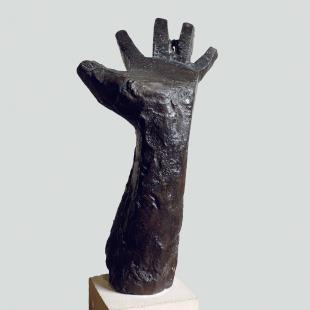
The Pill by Lucio Fontana (1967), based on a minimal gesture, in the clean cut that opens a compact body, accompanies the powerful torn hands by Juli González (1942). Both refer to the revolt and seek maximum expressive effectiveness, but from opposing formal principles. However, their difference talks to us of a continuity of the expressive avant-garde demand and of some struggles (that of women for free sexuality and that of Montserrat for the attacked Republic) that are, in the end, in solidarity.
and Juli González. Raised Right Hand / Raised Left Hand, c. 1942
Someone commented on the networks that taking works out of their context and combining different eras seemed frivolous to them. They were wrong, because they forget that, by definition, art is always out of context, out of place in museums. The museum is the place of art, the device that allows us to protect and, above all, where we can look at art, think about it, enjoy it. But art is done in workshops, it has furnished houses and palaces, environments of domesticity, it has formed part of architectural works (think of medieval art as a total art associated with religious liturgy). Perhaps it is true that contemporary art feels better in the museum, the aspirational space of the modern artist. But still there is never a single spatial response to the work. Every time we place it, present it and relate it to a whole (a collection or an exhibition) we are interpreting the work, we are making it.
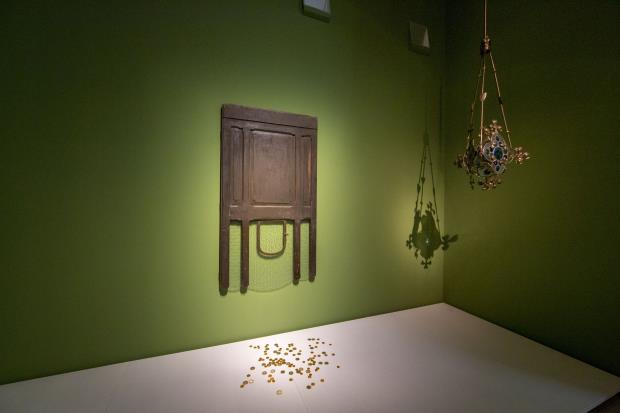
and Josep Puig i Cadafalch. Hanging lamp with floral decoration, c. 1900
Joan Brossa’s Capitomba, the upside-down bench window from which chocolate coins fall childishly, introduces an ironic commentary that contrasts with the somewhat pretentious opulence of bourgeois furniture from the modernist era and leads us to question the value of money and our material possessions.
+ Josep Puig i Cadafalch. Hanging lamp with floral decoration, c. 1900
Intrusive dialogues, a choral symphony in many voices
Seen from the outside, Intrusive Dialogues is a seemingly simple project in terms of approach (and we think that this simplicity and immediacy are a communicative virtue), but that it involves painstaking prior work. Each decision depends on many previous criteria and questions where the vision of the different curators come together, the exhibiting conditions of the works by nature being very different, the reflections of the museography teams, the perspective of the people in charge of communication, from designers to educational teams. Sergi Aguilar, curator and director of the Suñol Foundation, certainly brings an eminently artistic view, extremely subtle and intelligent. We start from a more historiographical and, at times, thematic position. The difference has been fertile and complementary.
The exhibition is established based on a mergence, from a debate in various voices where, in the end, each work has found its place. The collaboration between local institutions leads, in any case, a new sustainability.
Although the process of developing this project has been especially successful, it should not only be for those of us who have worked on it, but for the general public, over the coming months. The questions that have arisen, the debates, the doubts and the reflections must be elaborated in a publication that the project will gather together.
But the exhibition is still in process. We will have the opportunity to do activities and open the channels so that everyone, the people who come to a museum that is yours, activates it and propose the continuity of a present that, necessarily, must be shared.
Related links
Intrusive dialogues. Everything present
Digital plans. Intrusive dialogs
Art modern i contemporani







